#vinyl flooring market size
Explore tagged Tumblr posts
Text
The vinyl flooring market is expanding rapidly due to its affordability, durability, and versatile design options. Increasing demand from residential and commercial sectors, combined with advancements in eco-friendly materials and easy installation techniques, drives growth. Innovations in luxury vinyl tiles (LVT) and sustainable solutions are reshaping the market's competitive landscape.
0 notes
Text
Luxury Vinyl Flooring Market trends growth & Analysis
https://www.researchnester.com/reports/luxury-vinyl-flooring-market/6214
1 note
·
View note
Text
#Vietnam Vinyl Flooring Market#Market Size#Market Share#Market Trends#Market Analysis#Industry Survey#Market Demand#Top Major Key Player#Market Estimate#Market Segments#Industry Data
0 notes
Text
The Global Luxury Vinyl Tile Floor Covering Market is expected to reach USD 27.16 billion in 2023 and grow at a CAGR of 9.98% to reach USD 43.70 billion by 2028. Mohawk Industries, Shaw Industries Group, Inc., Armstrong Flooring, Mannington Mills, Inc., Tarkett are the major companies.
#Luxury Vinyl Tile Floor Covering Market Size#Luxury Vinyl Tile Floor Covering Market Share#Luxury Vinyl Tile Floor Covering Market Trends#Luxury Vinyl Tile Floor Covering Market Growth#Luxury Vinyl Tile Floor Covering Market Analysis#Luxury Vinyl Tile Floor Covering Market Forecast#Luxury Vinyl Tile Floor Covering Market Report#Luxury Vinyl Tile Floor Covering Industry Report
0 notes
Note
Since you're Australian, why are so many of the posts from the US? Did you start with Australia and then move onto other countries once you'd felt like you exhausted it? Or is the US particularly interesting for your purposes?
A big part of the reason is the enormous difference in scale. Australia has about 25 million people, versus 300 or so million in the US. Each of the 50 states has at least one or two major cities, most have many more than that. In addition to the volume of real estate imagery produced by this market, there are a few things about the US in this context which draw me in from an Australian perspective. One is how real estate listings weirdly embody how much more visually apparent the harmful economic forces of the past 50 years are in American society than they are here or elsewhere. Australia's welfare state was developed roughly during the same time as in the US, and has similarly been cut back since the 1970s. But it was always much weaker in the US than in Australia or Western Europe, and correspondingly the effects of its deterioration - along with other economic trends - have been much more visible than they are here. The way this is played out in terms of localised funding for public services means that many American cities have pockets (of varying sizes) where poverty and other forms of systemic oppression are concentrated and left open to the elements. The sort of stuff Jacob Holdt documented in his photos in the 70s, or that you see in a lot crime films and thrillers with location shooting. Gentrification and other forces since then have pushed these pockets into other areas and made some places seem less grim, but from what I've heard it seems like it would be hard for the average person in the US to ignore that these large, systemic problems exist. Conversely, in Australia, this kind of intense poverty has been pushed into the margins of society during the same time period - to remote communities (where people suffer from chronic diseases that have been eradicated in most other wealthy countries), country towns with shrinking economies, or to the fringes of larger cities (where people sleep in their cars in parking lots, or multiple families form sharehouses to afford $400-500+ pw rents). Though as things have gotten worse, particularly since COVID, it's getting harder to ignore. But still there's a substantial part of the population here who have grown up in ignorance of any of the larger, percolating structural problems in Australian society, and who proactively retain that ignorance into adulthood.
I think you can see these different perspectives play in out in real estate listings. In most American states, even in most of the towns I've looked at, you can see a broad spectrum of living conditions (and commercial interpretations of ideal living conditions) - from burnt out trailers, to overpriced renovated shitty older houses with cheap grey vinyl flooring and white walls, to clearly lived-in time capsules to McMansions to actual mansions. Some photographs are clearly shot by owners, others by real estate agents with a great variety of care and attention to detail (from elaborate staging to crime scenes). Rightly or wrongly, I feel like I get a broader, more honest (or at least more direct) feel for the housing crisis. It's a more honest horror film.
Australian listings, I think in part due to concentrations in corporate power in the real estate industry (similar to other monopolies that have formed in our economy), tend to more heavily adhere to the visual language of advertising and are more heavily regulated by agencies. The problems still exist, the housing market here is among the worst in the world and little effort is being made to address the underlying structural issues, but you can see the lack of will to acknowledge these issues in the level of gloss that's applied. You can look at a listing of an older house in Western Australia, for instance, and know for a fact that it's riddled with asbestos and probably has several other structural issues, but most likely enough time and effort will have been spent on staging and lighting and maybe surface-level renovations that it will seem otherwise fine. Lots of turds that have been polished successfully enough that you need insider knowledge to properly identify them as dogshit. Incidentally, I spent part of my childhood in a house built in the 1960s that had asbestos in the walls and ceiling.
I'm still interested in images from Australian listings (and other sources) though, I just look for other things that are interesting. Anything that runs contrary to the artificially positive, limited world view that advertising promotes. Even if its a poorly-lit time capsule that is directly aesthetically opposite to the ideal of house-beauty at the moment, or an obviously run-down house that has had every realtor photography trick in the playbook thrown at it until it becomes deeply uncanny. And it's always interesting to see what other people find interesting; I genuinely think the housing crisis underwrites every other political issue we have to contend with, its tendrils extend in many different directions, and I think this also means imagery like this can reach people in a diversity of ways. Aesthetically, nostalgically, inspiring fear and self-loathing and horror. All good sources of inspiration for creativity.
381 notes
·
View notes
Photo
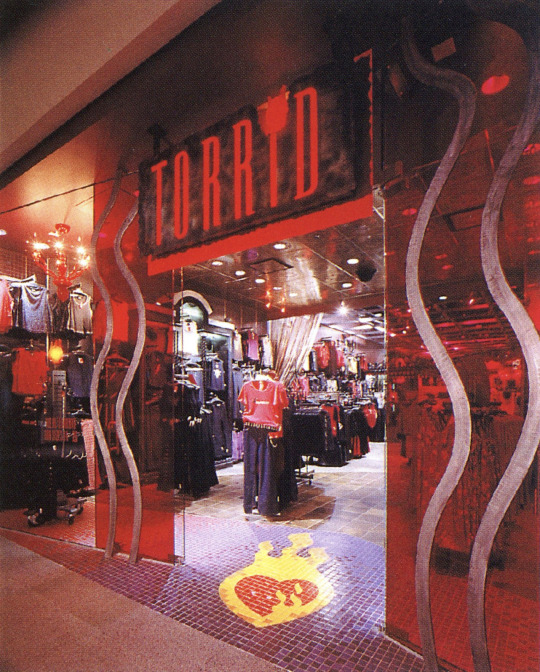
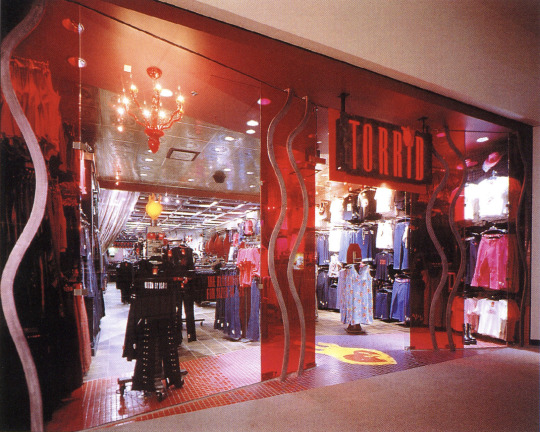
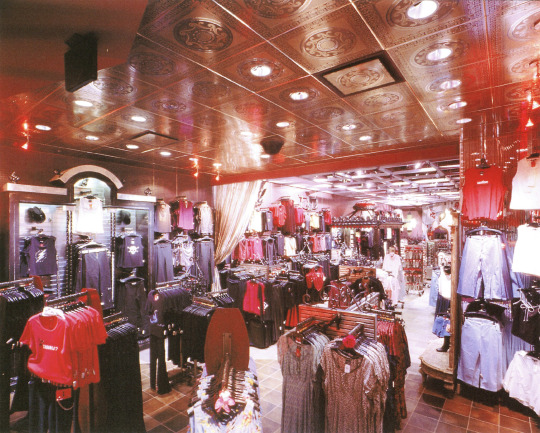


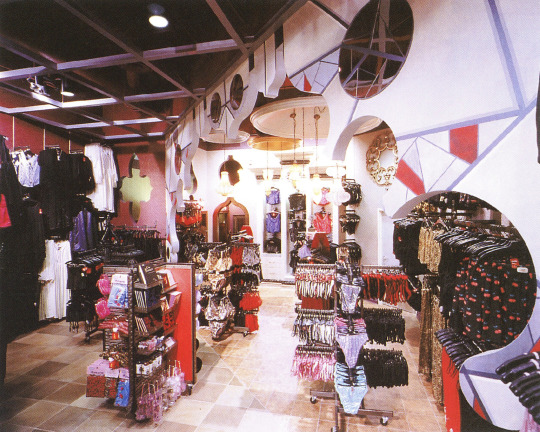
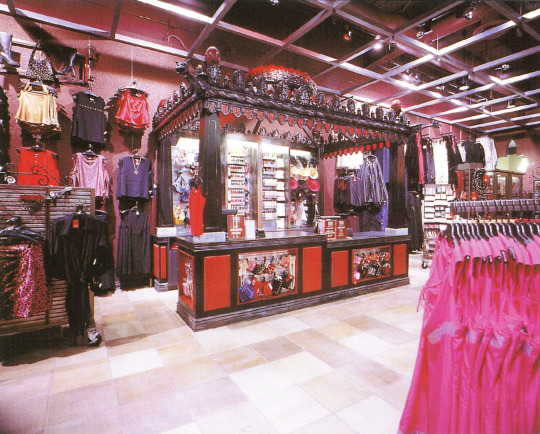
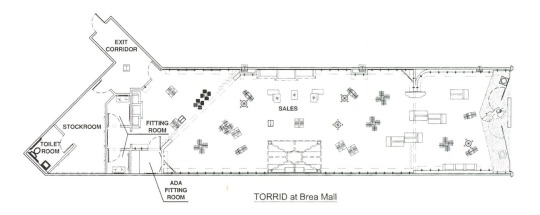
The first Torrid store - Brea Mall - Brea, CA (Opened April 18, 2001)
Designed by JGA, Inc.
From the book: “The retailer, Hot Topic, based in City of Industry, CA, started a short 12 years ago with a concept and a target market; cutting edge apparel, accessories and novelty items--all inspired by alternative music, oriented towards a hip and trendy, teenage market. Hot Topic changed the look of their retail settings, which are usually located in mainstream malls, and the company has recently taken aim at another special market. The new focus is on plus-size teens; an area that the fashion market seems to have neglected.
Up until this time the 15-30 year old hip and trendy young women who wear sizes 14-26 had no other choice but to shop in the larger size women's shops where the fashions were tailored to the more matronly and conservative tastes. That is how Torrid was born!
Torrid was introduced in a new, hot and fun retail setting designed by JGA, Inc. of Southfield, MI which has designed the various prototypes for the Hot Topic stores as well. To be sure of the need for such a niche to be filled, the company opened five Torrid shops almost simultaneously; the first in Brea, CA, followed by stores in malls in Mission Viejo, CA, Annapolis, MD, Omaha, NE, N. Attleboro, MA, and Littleton, CO. The merchandise offerings are clustered as "Streetwear," "Clubwear," Rockabilly Wear," and Renaissance Wear" and the stores average about 2,750 SF. Besides the "everyday" slacks and novelty T-shirts, these larger size young women can find black vinyl pants and mini-skirts, black corsets, dog-collar chokers and platform shoes as well as retro-inspired clothing and accessories. In addition to the gothic and prom dresses, Torrid also carries a full line of lingerie for this particular market. Listening to the target market, Hot Topic's Torrid offers teenagers and up the opportunity to look "girly yet fierce."
The design objective for the prototype store that was designed by JGA, Inc. was to create "a celebration of abundance" and make the setting as unique, unconventional and spirited as the plus-size young women who will be shopping here. Inspired by a "mythological, after-hours club in New Orleans," the atmosphere is romantic, dark and filled with a sense of "unbridled passion." "From the signature flaming heart icon to the curving voluptuous lines throughout the store, excessive materials and scale mirror the zest of the Torrid woman." It starts out front with the shopper-stopping facade which serves as a dramatic gateway to the store.
The curvaceous and sensuous "hourglass" figures of the Torrid customer is expressed in the hand-crafted metalwork and the backlit translucent glass glowing red. A "drippy" red chandelier and the hand blown flaming heart torcheres add to the store's distinctive sense of place and being. The mosaic porcelain tile floor sets the color palette of jewel tones and metallics. "Visually complex, layers of finishes and architectural pieces evoke a one-of-a-kind artistic flavor." The eclectic mix of fixtures, furniture and furnishings-even the armoires--add to the New Orleans flavor. The hand painted, whimsical and overscaled armoires or cabinets are used to anchor the various zones within the store and at the center of the space a large bronze metallic drape further divides the departments.
The designers added special touches to each area to create that unique, one-of-a-kind feeling to the design. Specially designed, oversized red sculptured chairs with slatted backs are featured in the shoe area. Shoes and accessories are displayed on the slatted backs. The lingerie area takes on a more intimate and exotic--almost Moroccan--feeling with the hand blown glass chandeliers suspended down from large plaster domes. Seen behind this area--beyond a hand painted wall and arc--are the individual, oversized dressing rooms which are equipped with flattering uplights and decorative chandeliers that are visible from other parts of the store. The cash wrap becomes a "focal fantasy" in the total design and it resembles a giant canopy bed topped with twisting shapes and forms.
The space is filled with a pulsating excitement that is so appropriate for the merchandise and the young clientele. In addition to the shimmering palette of rich, deep colors, the warm colored downlights not only enrich the ambient colors and textures but they enhance the merchandise display. The traditional long and narrow mall space is broken up into more personal and individual zones by the variations in ceiling heights, the tin ceilings, finials and the assorted wall coverings. The use of brocades, metallics, and jewel tones on the walls also help to differentiate areas in the store. The metal fixture system--tortoise shell like in appearance--was customized to accommodate the products unique size and length requirements.
If all goes as well as anticipated we can expect to see more and more Torrid shops opening up across the USA- maybe even as many as 700 outlets!”
Images and text were scanned from the book, Stores of the Year 14 by Martin Pegler (2003)
415 notes
·
View notes
Text
Why opt for a vinyl swimming pool?
The backyard Vinyl Swimming Pools are increasingly sought after by those wishing to build a leisure space at home. Discover this type of pool and its advantages. Because of its excellent value for money, the vinyl composite pool is one of the most popular projects. Find out how this type of swimming pool is made and know its advantages and maintenance at the time of maintenance.

The vinyl composite pool is not as rigid as the fiber pool. It is their coating that differs. It covers the structure, usually masonry, built below ground level. Check out how to build a vinyl pool from scratch:
The construction begins with the demarcation of the land because the pool can take shape and size chosen by the customer.
As soon as the land is delimited, the space is dug and prepared to provide for the swimming pool installation.
Then an iron trellis suitable for the installation of the swimming pool is installed, and a layer of mortar and waterproof plaster on the ground is deposited.
The walls are then covered with concrete blocks that adapt to any type of soil, whether dry, sandy, or wet.
Then the finishes are made for the installation of the devices, such as the suction, the evacuation of the water, the bottom drainage, and the return.
Finally, the vinyl coating is applied to cover the entire structure, and a vacuum system does its fixing.
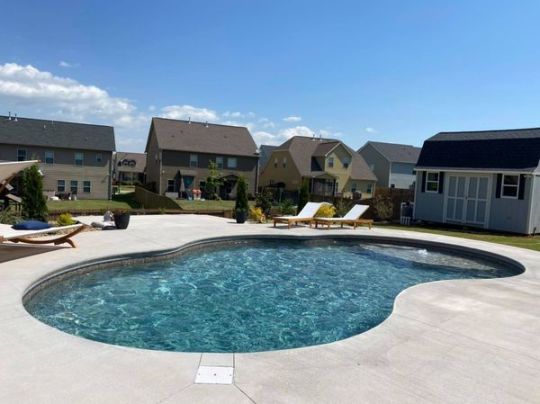
The vinyl is custom-made and will be spread all over the pool to the walls. The pool-filling process can then begin. During this time, an industrial vacuum removes the air between the bag and the pool structure. In this way, the coating will not present creases or deformations.
Since it is a waterproof material, vinyl composite is also an excellent choice for those who need to renovate a concrete swimming pool, for example, with leakage problems.
In this case, prior maintenance is required to repair holes and broken tiles. A pre-vinyl cover is also applied so that the coating does not get abraded with the rest of the materials used.
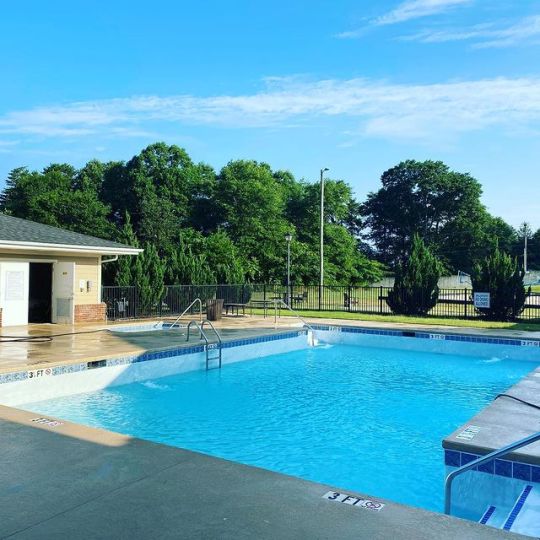
The advantages of the vinyl swimming pool
Vinyl pools offer many advantages:
Cost: construction requires less material and less labor to finish, resulting in shorter turnaround times and faster delivery
Waterproofing: the vinyl does not require the application of another waterproofing material since it already fulfills this function by itself, which also reduces costs
Maintenance: There is no need to replace materials like broken tiles.
Cleaning: vinyl is easy to clean and has a more hygienic appearance
Size and shape: as the construction of the vinyl is custom-made, there is no size or format limit for the construction of the pool
Customization: there are a large number of prints and colors on the market. For example, you can even personalize the vinyl by printing a logo or a coat of arms.
If you are embarking on the project of creating your vinyl swimming pool, it is recommended that you pay attention not only to the quality of the flooring but also to the construction of the structure. It is important to always call on the Best Pool Builders in North Carolina that will provide you with expert work. This will ensure the best value for your pool.
2 notes
·
View notes
Text
The vinyl flooring market is experiencing significant growth, driven by its durability, affordability, and aesthetic versatility. Rising construction activities in residential and commercial sectors, coupled with increasing demand for eco-friendly and low-maintenance flooring options, are key factors boosting market expansion. Innovations like luxury vinyl tiles (LVT) and rigid core vinyl are further enhancing appeal due to their realistic designs and water-resistant properties. Additionally, growing urbanization and remodeling trends fuel demand. The market is also benefiting from technological advancements in manufacturing processes, offering better texture, patterns, and sustainable materials, ensuring vinyl flooring remains a preferred choice in the global flooring industry.
#Vinyl Flooring market#Vinyl Flooring market size#Vinyl Flooring market share#Vinyl Flooring market demand#Vinyl Flooring market trends
0 notes
Text
0 notes
Text
#Vietnam Vinyl Flooring Market#Market Size#Market Share#Market Trends#Market Analysis#Industry Survey#Market Demand#Top Major Key Player#Market Estimate#Market Segments#Industry Data
0 notes
Text
Industrial Flooring Market is valued at approximately USD 9,515.5 million and is projected to grow at a compound annual growth rate (CAGR) of 5.20% over the forecast period, reaching around USD 14,274.38 million by 2032. The industrial flooring market has emerged as a vital component in various industries, offering durable, safe, and performance-driven flooring solutions. Industrial flooring plays a critical role in environments such as manufacturing plants, warehouses, pharmaceutical facilities, and food processing units, where flooring must withstand heavy machinery, chemicals, and rigorous wear and tear. The global industrial flooring market is experiencing robust growth, driven by industrialization, urbanization, and a heightened focus on workplace safety and efficiency.
Browse the full report at https://www.credenceresearch.com/report/industrial-flooring-market
Market Size and Growth
The global industrial flooring market was valued at approximately USD 7 billion in 2024 and is projected to reach USD 12 billion by 2032, growing at a compound annual growth rate (CAGR) of around 6.5% during the forecast period. This growth is attributed to increasing demand from end-use industries, particularly in emerging economies undergoing rapid industrial expansion. The need for flooring solutions that meet stringent regulatory standards and offer high resistance to chemicals, abrasion, and impact is fueling market growth.
Key Market Drivers
One of the primary drivers of the industrial flooring market is the rapid expansion of the construction and manufacturing sectors. With industries seeking to modernize their facilities to improve operational efficiency, the demand for specialized flooring solutions that enhance durability and safety is on the rise. Additionally, the growth of e-commerce and logistics has increased the number of warehouses and distribution centers, further driving demand for industrial flooring.
Technological advancements in flooring materials, including epoxy, polyurethane, and vinyl, have also contributed significantly to market growth. These materials offer superior resistance to chemicals and abrasion, longer lifespans, and easy maintenance, making them ideal for industrial applications. Furthermore, the growing emphasis on sustainability has spurred the development of eco-friendly and recyclable flooring materials, aligning with global environmental goals.
Market Challenges
Despite its promising growth trajectory, the industrial flooring market faces certain challenges. High installation costs and the complexity of flooring systems can act as barriers, particularly for small and medium-sized enterprises (SMEs). Additionally, variations in raw material prices, including epoxy resins and polyurethanes, can affect market dynamics. The need for skilled labor for installation and maintenance also poses a challenge, especially in developing regions.
Future Trends and Opportunities
The industrial flooring market is set to witness several trends that will shape its future. The adoption of smart flooring technologies that integrate sensors to monitor temperature, load, and wear conditions is expected to grow, offering enhanced functionality. The demand for anti-slip and antimicrobial flooring solutions will also rise, particularly in sectors like food processing and healthcare.
Sustainability will remain a critical focus, with manufacturers investing in recyclable and low-emission materials. Innovations in self-healing and energy-efficient flooring systems are also expected to gain traction, aligning with the evolving needs of modern industries.
Key Player Analysis:
BASF SE
Sika AG
RPM International Inc.
Mapei U.K. Ltd.
Fosroc
Don Construction Products Ltd.
Cipy Polyurethanes Pvt Ltd.
Viacor Polymer GmBH
Twintec, Acrylicon
Cornerstone Flooring
Applied Flooring
AVCON Technics Pvt. Ltd.
4m Europe
East Coast Flooring Ltd
Segmentation:
Based on Product Type:
Epoxy Flooring
Polyurethane Flooring
Vinyl Flooring
Concrete Flooring
Rubber Flooring
Other Specialty Flooring
Based on Technology:
Traditional Flooring Solutions
Advanced Flooring Solutions
Smart Flooring Technologies
Self-Leveling Compounds
Modular Flooring Systems
Based on End-User:
Manufacturing
Logistics and Warehousing
Food and Beverage
Healthcare
Retail
Other Industrial Sectors
Based on Region:
North America
United States
Canada
Mexico
Europe
United Kingdom
Germany
France
Italy
Spain
Asia-Pacific
China
India
Japan
Australia
South Korea
Latin America
Brazil
Argentina
Chile
Middle East and Africa
United Arab Emirates
South Africa
Saudi Arabia
Egypt
Browse the full report at https://www.credenceresearch.com/report/industrial-flooring-market
Contact:
Credence Research
Please contact us at +91 6232 49 3207
Email: [email protected]
0 notes
Text
Custom-Made Tarps for Holiday Market Stalls: Stay Festive and Functional

The holiday season brings an array of vibrant market stalls, each showcasing unique products and festive decorations. A vital aspect of these setups is the use of custom-made tarps. These versatile covers not only offer protection against weather elements but also enhance the visual appeal of vendor booths. Whether you're a seasoned vendor or a newcomer, incorporating custom tarps into your stall design ensures functionality and festivity throughout the season.
Why Custom-Made Tarps Are Essential for Holiday Market Stalls
Custom tarps are the unsung heroes of holiday markets. They provide a tailored solution to cover and protect stalls, ensuring products and decorations remain in pristine condition. Designed to withstand varying weather conditions, these tarps help vendors maintain an inviting atmosphere, no matter the forecast.
Weather Protection for Vendor Booths
Holiday markets often take place outdoors, exposing stalls to unpredictable weather. Custom tarps act as a shield, protecting goods from rain, snow, and wind. Made from durable materials like vinyl or polyethylene, these tarps ensure that your inventory remains safe and dry, preventing potential losses.
Rain and Snow Resistance: High-quality tarps are waterproof, making them ideal for snowy or rainy conditions.
Wind Protection: Securely installed tarps act as a barrier against strong winds, keeping your booth stable and secure.
Custom Tarps Enhance Aesthetic Appeal
In a competitive holiday market, visual appeal plays a crucial role in attracting customers. Custom tarps can be tailored with festive designs, colors, or branding to align with the holiday spirit.
Seasonal Colors: Opt for red, green, or gold tarps to resonate with the holiday theme.
Branding Opportunity: Include logos, taglines, or product images on the tarp to reinforce brand identity.
Lighting Integration: Reflective tarps can amplify decorative lighting, creating an eye-catching display.
Durability and Longevity
Investing in custom-made tarps ensures durability, saving vendors from recurring expenses. These tarps are designed for repeated use, maintaining their quality over several holiday seasons.
Material Choices: Heavy-duty vinyl or canvas tarps resist wear and tear.
UV Protection: Tarps with UV-resistant coatings prevent fading and deterioration from sunlight exposure.
Easy Installation and Custom Fit
One of the standout features of custom tarps is their ability to fit any booth size or shape. This precise fit ensures that your stall remains fully covered, eliminating gaps that could expose your goods to the elements.
Custom Sizing: Measurements tailored to your stall dimensions.
Ease of Setup: Grommets and reinforced edges simplify installation, saving time and effort.
Versatile Uses Beyond Covering Stalls
Custom tarps aren’t limited to providing overhead protection. Their versatility makes them an indispensable tool for various applications in holiday markets:
Sidewalls: Protect against wind and provide privacy.
Flooring: Create a clean and dry surface for displays.
Partitions: Divide larger spaces into organized sections.
Cost-Effective Solution for Vendors
While the initial investment may seem significant, custom tarps are a cost-effective solution in the long run. Their durability reduces the need for frequent replacements, and their protective qualities prevent product damage, leading to potential savings.
Reusable: With proper care, custom tarps last multiple seasons.
Minimal Maintenance: Easy to clean and store for future use.
Eco-Friendly Options
For vendors conscious of their environmental impact, eco-friendly tarp options are available. Made from recyclable or biodegradable materials, these tarps provide the same functionality while promoting sustainability.
Biodegradable Materials: Options like canvas tarps that decompose naturally.
Recyclable Solutions: Polyethylene tarps that can be repurposed.
How to Choose the Right Custom-Made Tarp
Selecting the perfect tarp involves considering factors like material, size, and design. Vendors should assess their specific needs and work with reliable suppliers to create a tarp that meets their requirements.
Material Selection: Choose materials based on weather conditions and desired durability.
Customization Options: Look for suppliers that offer design flexibility, including color, print, and size.
Supplier Reputation: Partner with experienced manufacturers for high-quality results.
Conclusion: Celebrate the Holidays with Custom-Made Tarps
Holiday markets are a bustling hub of festive cheer, and ensuring your stall stands out is vital for success. Custom-made tarps combine protection and aesthetics, making them an indispensable asset for vendors. By investing in these tailored solutions, you can focus on creating memorable customer experiences without worrying about the elements.
0 notes
Text
Soft Flooring Market Insights & Trends: Size, Growth, Share, and Forecast to 2031

The global soft flooring market is on a steady growth trajectory, with significant expansion expected in the coming years. Valued at USD 88.43 billion in 2023, the market is projected to grow from USD 91.43 billion in 2024 to USD 119.47 billion by 2032, expanding at a compound annual growth rate (CAGR) of 3.4% during the forecast period from 2024 to 2032. This growth is driven by increasing demand for aesthetic and functional flooring solutions across various industries, including residential, commercial, and industrial applications.
Market Definition
Soft flooring refers to floor coverings that provide a cushioned, comfortable surface. These materials are designed to enhance the aesthetic appeal of both residential and commercial spaces while offering functional benefits such as insulation, noise reduction, and enhanced comfort. Soft flooring solutions include carpets, vinyl, rubber, linoleum, and other cushioned materials that are used in various sectors like residential, commercial, and institutional buildings.
For a deeper insight into this growing market, access a full PDF sample copy of the report here: https://straitsresearch.com/report/soft-flooring-market/request-sample.
Market Dynamics
Key Trends:
Growing Demand for Sustainable Flooring Solutions: As sustainability becomes increasingly important in the construction and renovation sectors, there is a growing demand for eco-friendly soft flooring materials. Consumers and businesses alike are opting for flooring options made from recyclable and natural materials such as rubber, linoleum, and sustainably sourced carpets.
Increased Adoption in Commercial Spaces: Soft flooring is gaining popularity in commercial spaces, including offices, hospitality establishments, and retail environments, due to its aesthetic appeal, comfort, and durability. The growing demand for comfort-driven workplace environments is propelling this trend forward.
Technological Advancements in Flooring Materials: Innovations in soft flooring materials are creating products with improved durability, ease of maintenance, and better environmental profiles. The development of stain-resistant, moisture-resistant, and antimicrobial soft flooring solutions is driving growth in both residential and commercial applications.
Growth Factors
Several factors are contributing to the growth of the soft flooring market:
Rising Residential and Commercial Renovation Activities: As renovation activities increase globally, the demand for soft flooring solutions is also on the rise. Homeowners and businesses are increasingly opting for soft flooring to enhance interior aesthetics and provide comfort, especially in living rooms, bedrooms, and office spaces.
Expanding Construction Industry in Emerging Markets: The rapid urbanization and expansion of the construction sector in emerging economies, especially in regions like Asia-Pacific and Latin America, are driving demand for soft flooring. This is particularly evident in residential construction, where soft flooring options are becoming a preferred choice for new builds and renovations.
Technological Advancements in Flooring Solutions: Continuous innovations in the soft flooring segment, such as improved durability, stain resistance, and sustainability, are expected to fuel market growth. Additionally, the increasing availability of premium and luxury soft flooring products will further boost consumer spending on high-quality flooring options.
Key Market Opportunities
Growing Demand for Green and Sustainable Flooring Solutions: As environmental concerns rise globally, there is a growing opportunity in the market for soft flooring solutions made from sustainable, eco-friendly materials. Products like natural fiber carpets, rubber flooring made from recycled materials, and linoleum made from renewable resources are becoming increasingly popular.
Increased Use of Soft Flooring in High-Traffic Areas: With soft flooring being recognized for its durability and comfort, there is increasing adoption in high-traffic areas such as offices, hospitals, and commercial establishments. The demand for advanced solutions that offer enhanced durability and aesthetic appeal continues to rise.
Expansion in Emerging Markets: The increasing disposable income and improving standard of living in emerging markets, particularly in Asia-Pacific, offer significant opportunities for market expansion. Manufacturers are increasingly focusing on these regions to capture the growing demand for soft flooring solutions in both residential and commercial spaces.
Market Segmentation
The soft flooring market is segmented based on product type, material, application, and distribution channels. This segmentation provides insights into consumer preferences, industry trends, and market opportunities.
By Product:
Area Rugs
Carpet Tiles
Broadloom Carpet
By Material:
Rubber
Linoleum
Vinyl
By Application:
Commercial
Builder/New Construction
Residential Replacement
By Distribution Channel:
Specialty Stores
Other Channels
Home Centers
Contractors
For a more detailed look at the market segmentation, visit: https://straitsresearch.com/report/soft-flooring-market/segmentation.
Key Players in the Soft Flooring Market
The soft flooring market features several global and regional players that are leading the way in innovation, product development, and market expansion. Some of the key companies in the market include:
Rephouse
Softfloor
Flexco
Nora
RubberFloorin Inc
Bergo Flooring
Burke
Roppe
Jilink
WICANDERS
Deho
Senking
Hi-Step
CAROLIM
HARO
These players are investing in research and development to create advanced, durable, and environmentally friendly flooring solutions. Strategic partnerships and acquisitions are also a part of their growth strategy to expand their market presence.
Regional Insights
The North American region currently dominates the soft flooring market due to the high demand for premium and eco-friendly flooring solutions in both residential and commercial applications. The presence of leading manufacturers and a well-established construction industry further strengthens the region’s market position.
Asia-Pacific is the fastest-growing region, driven by rapid urbanization, increasing disposable income, and expanding construction activities. The demand for soft flooring in both residential and commercial sectors is on the rise, and the market in this region is expected to continue growing throughout the forecast period.
About Us:
StraitsResearch.com is a leading market research and market intelligence organization, specializing in research, analytics, and advisory services along with providing business insights & market research reports.
Contact Us:
Email: [email protected] Tel: +1 646 905 0080 (U.S.), +44 203 695 0070 (U.K.) Website: https://straitsresearch.com/
0 notes
Text
0 notes
Text

1711 E. Tucker Blvd
Arlington, Texas 76010
RENT:$1,750
Available 12/18/2024
3 beds•2 baths•1,320 sqft.
Apply Now:
View Listing:
Good Size 3 Bedroom!
Spacious 3 Bedroom 1.5 Bathrooms! The large Living Room Space is great for entertaining & the property has vinyl flooring throughout & new painting. The Kitchen is good size & open to the Dining Room area & has new light fixtures, also there is plenty of pantry space. All 3 Bedrooms are a good size with sufficient closet space. The Utility Room is a great size & could be used to store additional items. The Fenced in back yard offer great space for entertainment.
Contact us: 817-640-2064
"Discover The Classic Difference"
#dallas fort worth real estate market#dfw#houseforrent#dfwrealestate#dfwhomes#dallas/fort worth metroplex#arlington star telegram#arlington homes#arlingtontexas#Arlington#For Lease#classic property management#zillowrentals#multiple listing service zillowzillow rentals realtor.comtrulia trulia homes hotpadsnorth arlington arlingtonarlington star telegram
0 notes
Text
0 notes